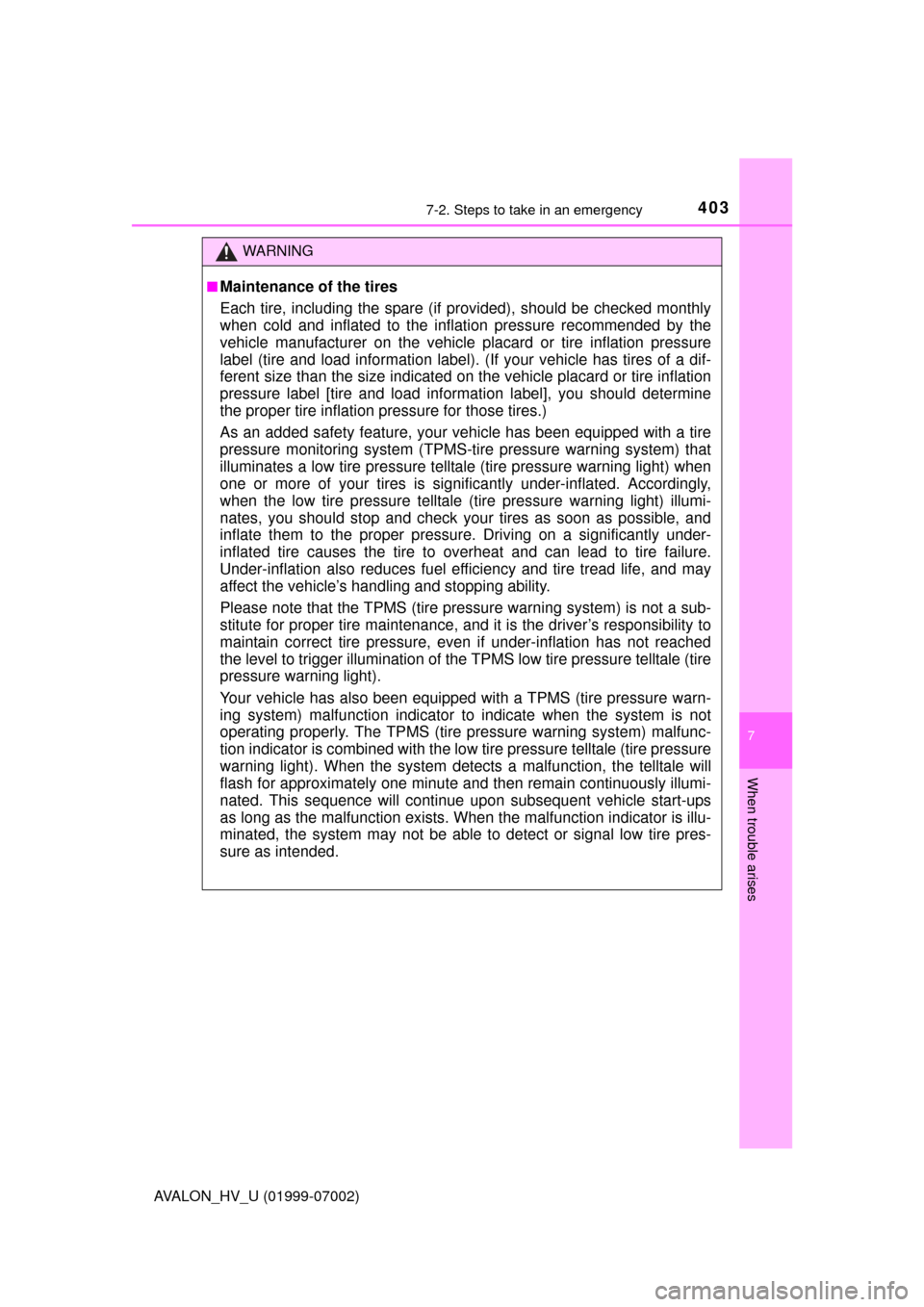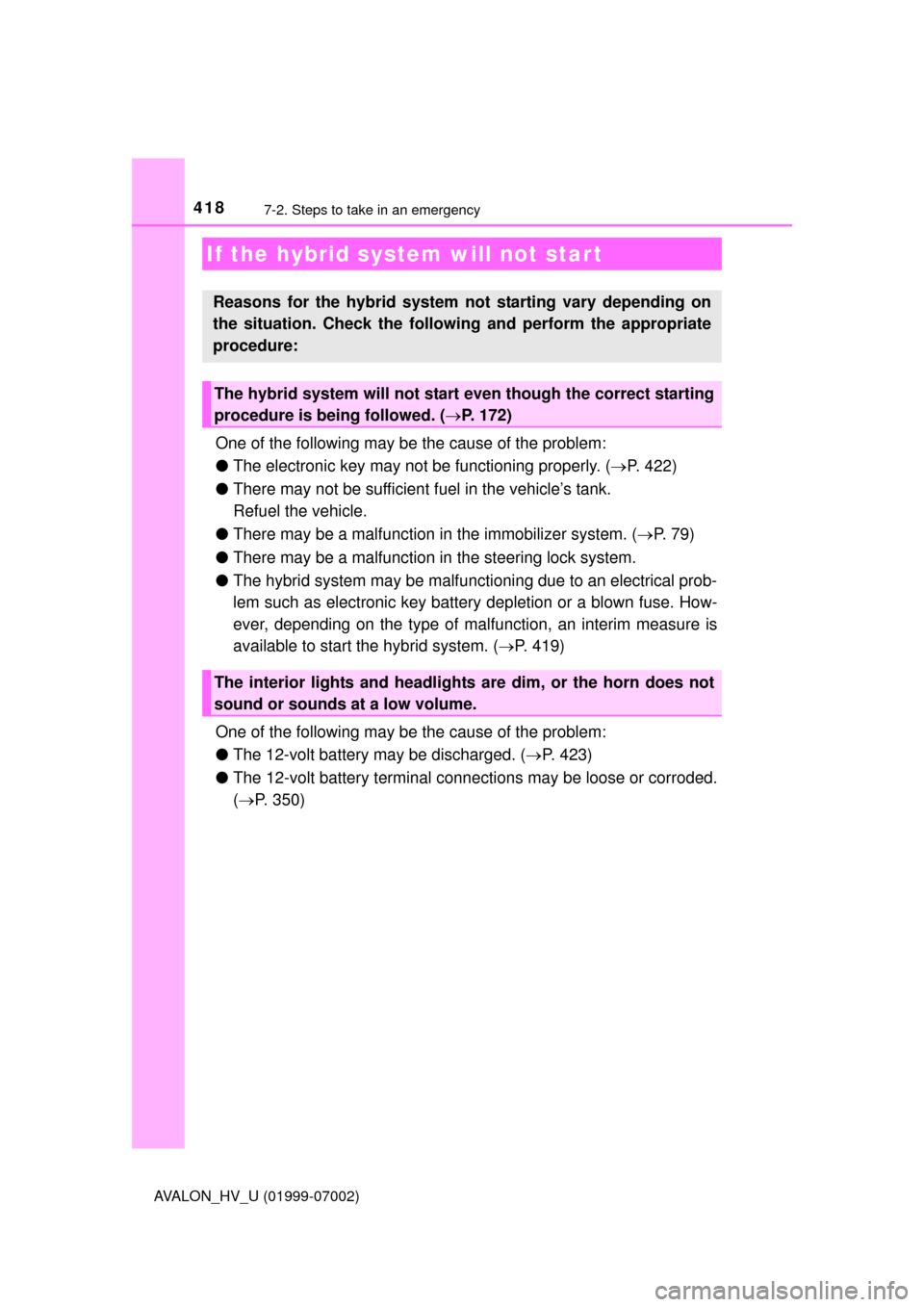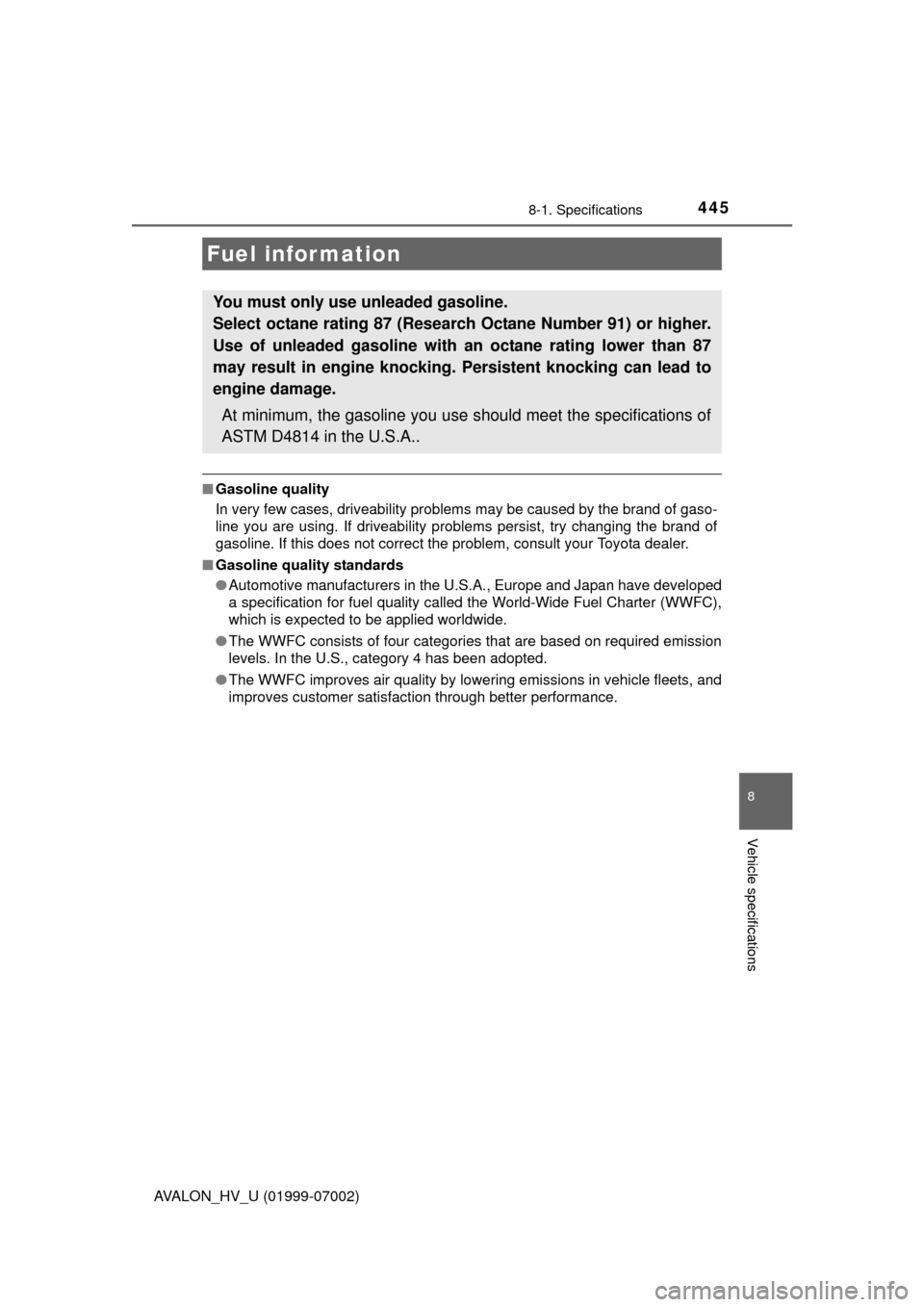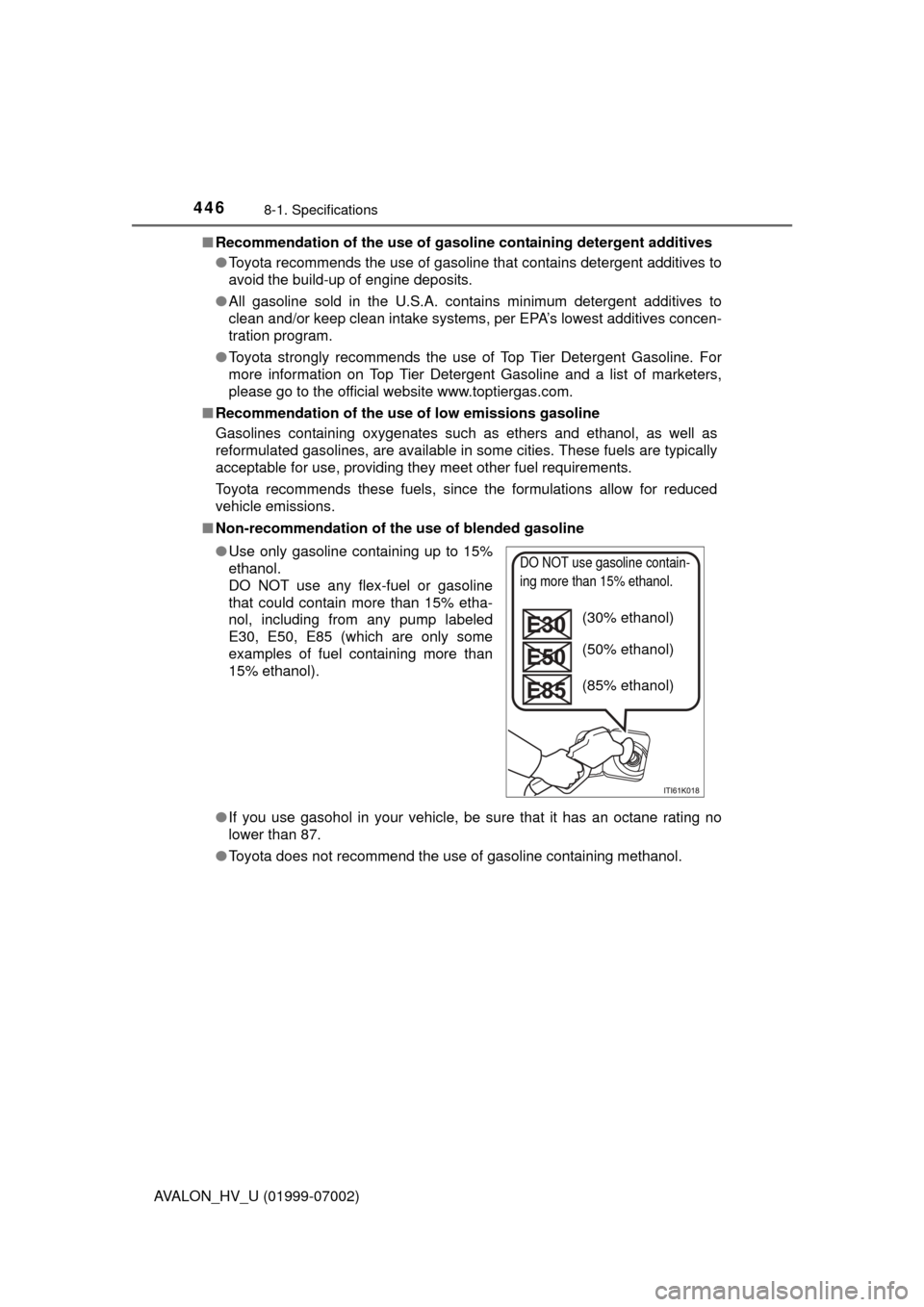Page 403 of 492

4037-2. Steps to take in an emergency
7
When trouble arises
AVALON_HV_U (01999-07002)
WARNING
■Maintenance of the tires
Each tire, including the spare (if provided), should be checked monthly
when cold and inflated to the inflation pressure recommended by the
vehicle manufacturer on the vehicle placard or tire inflation pressure
label (tire and load information label). (If your vehicle has tires of a dif-
ferent size than the size indicated on the vehicle placard or tire inflation
pressure label [tire and load information label], you should determine
the proper tire inflation pressure for those tires.)
As an added safety feature, your vehicle has been equipped with a tire
pressure monitoring system (TPMS-ti re pressure warning system) that
illuminates a low tire pre ssure telltale (tire pressure warning light) when
one or more of your tires is significantly under-inflated. Accordingly,
when the low tire pressure telltale (tire pressure warning light) illumi-
nates, you should stop and check your tires as soon as possible, and
inflate them to the proper pressure. Driving on a significantly under-
inflated tire causes the tire to overheat and can lead to tire failure.
Under-inflation also reduces fuel effi ciency and tire tread life, and may
affect the vehicle’s hand ling and stopping ability.
Please note that the TPMS (tire pres sure warning system) is not a sub-
stitute for proper ti re maintenance, and it is the driver’s responsibility to
maintain correct tire pressure, even if under-inflation has not reached
the level to trigger illumina tion of the TPMS low tire pressure telltale (tire
pressure warning light).
Your vehicle has also been equipped with a TPMS (tire pressure warn-
ing system) malfunction indicator to indicate when the system is not
operating properly. The TPMS (tire pressure warning system) malfunc-
tion indicator is combined with the lo w tire pressure telltale (tire pressure
warning light). When the system dete cts a malfunction, the telltale will
flash for approximately one minute and then remain continuously illumi-
nated. This sequence will continue up on subsequent vehicle start-ups
as long as the malfunction exists. When the malfunction indicator is illu-
minated, the system may not be able to detect or signal low tire pres-
sure as intended.
Page 418 of 492

4187-2. Steps to take in an emergency
AVALON_HV_U (01999-07002)
One of the following may be the cause of the problem:
●The electronic key may not be functioning properly. ( P. 422)
● There may not be sufficient fuel in the vehicle’s tank.
Refuel the vehicle.
● There may be a malfunction in the immobilizer system. (P. 7 9 )
● There may be a malfunction in the steering lock system.
● The hybrid system may be malfunctioning due to an electrical prob-
lem such as electronic key battery depletion or a blown fuse. How-
ever, depending on the type of malfunction, an interim measure is
available to start the hybrid system. ( P. 419)
One of the following may be the cause of the problem:
● The 12-volt battery may be discharged. ( P. 423)
● The 12-volt battery terminal connections may be loose or corroded.
( P. 350)
If the hybrid system will not star t
Reasons for the hybrid system not starting vary depending on
the situation. Check the follo wing and perform the appropriate
procedure:
The hybrid system will not start even though the correct starting
procedure is being followed. ( P. 172)
The interior lights and headlights are dim, or the horn does not
sound or sounds at a low volume.
Page 435 of 492
435
Vehicle specifications8
AVALON_HV_U (01999-07002)8-1. Specifications
Maintenance data (fuel, oil level, etc.) .......... 436
Fuel information ................ 445
Tire information ................. 448
8-2. Customization Customizable features ...... 461
8-3. Items to initialize Items to initialize ............... 468
Page 436 of 492
436
AVALON_HV_U (01999-07002)
8-1. Specifications
*: Unladen vehicle
Maintenance data (fuel, oil level, etc.)
Dimensions and weight
Overall length195.3 in. (4960 mm)
Overall width72.2 in. (1835 mm)
Overall height*57.5 in. (1460 mm)
Wheelbase111.0 in. (2820 mm)
Tread*Front62.6 in. (1590 mm)
Rear62.2 in. (1580 mm)
Vehicle capacity weight
(Occupants + luggage)930 lb. (420 kg)
Page 438 of 492
4388-1. Specifications
AVALON_HV_U (01999-07002)
Engine
Model2.5 L 4-cylinder (2AR-FXE)
Ty p e4-cylinder in line, 4-cycle, gasoline
Bore and stroke3.54 3.86 in. (90.0 98.0 mm)
Displacement152.2 cu. in. (2494 cm3)
Valve clearanceAutomatic adjustment
Fuel
Fuel typeUnleaded gasoline only
Octane Rating87 (Research Octane Number 91) or higher
Fuel tank capacity
(Reference)17.0 gal. (64.35 L, 14.2 Imp. gal.)
Electric motor (traction motor)
Ty p ePermanent magnet synchronous motor
Maximum output105 kW
Maximum torque199 ft•lbf (270 N•m, 27.5 kgf•m)
Hybrid battery (traction battery)
Ty p eNickel-Metal hydride battery
Voltage7.2 V/module
Capacity6.5 Ah (3HR)
Quantity34 modules
Overall voltage244.8 V
Page 440 of 492
4408-1. Specifications
AVALON_HV_U (01999-07002)■
Engine oil selection
“Toyota Genuine Motor Oil” is used
in your Toyota vehicle. Use
Toyota approved “Toyota Genuine Motor Oil” or equivalent to satisfy
the following grade and viscosity.
Oil grade: ILSAC GF-5 multigrade engine oil
Recommended viscosity: SAE 0W-20
SAE 0W-20 is the best choice
for good fuel economy and
good starting in cold weather.
If SAE 0W-20 is not available,
SAE 5W-20 oil may be used.
However, it must be replaced
with SAE 0W-20 at the next oil
change.
How to read oil container label
The International Lubricant
Specification Advisory Commit-
tee (ILSAC) Certification Mark
is added to some oil containers
to help you select the oil you
should use.
Outside temperature
Page 445 of 492

4458-1. Specifications
8
Vehicle specifications
AVALON_HV_U (01999-07002)
■Gasoline quality
In very few cases, driveability problems may be caused by the brand of gaso-
line you are using. If driveability problems persist, try changing the brand of
gasoline. If this does not correct the problem, consult your Toyota dealer.
■ Gasoline quality standards
●Automotive manufacturers in the U.S.A., Europe and Japan have developed
a specification for fuel quality called the World-Wide Fuel Charter (WWFC),
which is expected to be applied worldwide.
● The WWFC consists of four categories that are based on required emission
levels. In the U.S., category 4 has been adopted.
● The WWFC improves air quality by lowering emissions in vehicle fleets, and
improves customer satisfaction through better performance.
Fuel information
You must only use unleaded gasoline.
Select octane rating 87 (Research Octane Number 91) or higher.
Use of unleaded gasoline with an octane rating lower than 87
may result in engine knocking. Persistent knocking can lead to
engine damage.
At minimum, the gasoline you use s hould meet the specifications of
ASTM D4814 in the U.S.A..
Page 446 of 492

4468-1. Specifications
AVALON_HV_U (01999-07002)■
Recommendation of the use of gaso line containing detergent additives
● Toyota recommends the use of gasoline that contains detergent additives to
avoid the build-up of engine deposits.
● All gasoline sold in the U.S.A. contains minimum detergent additives to
clean and/or keep clean intake systems, per EPA’s lowest additives concen-
tration program.
● Toyota strongly recommends the use of Top Tier Detergent Gasoline. For
more information on Top Tier Detergent Gasoline and a list of marketers,
please go to the official website www.toptiergas.com.
■ Recommendation of the use of low emissions gasoline
Gasolines containing oxygenates such as ethers and ethanol, as well as
reformulated gasolines, are available in some cities. These fuels are typically
acceptable for use, providing they meet other fuel requirements.
Toyota recommends these fuels, since the formulations allow for reduced
vehicle emissions.
■ Non-recommendation of the use of blended gasoline
●If you use gasohol in your vehicle, be sure that it has an octane rating no
lower than 87.
● Toyota does not recommend the use of gasoline containing methanol.
●
Use only gasoline containing up to 15%
ethanol.
DO NOT use any flex-fuel or gasoline
that could contain more than 15% etha-
nol, including from any pump labeled
E30, E50, E85 (which are only some
examples of fuel containing more than
15% ethanol).
DO NOT use gasoline contain-
ing more than 15% ethanol.
(30% ethanol)
(50% ethanol)
(85% ethanol)